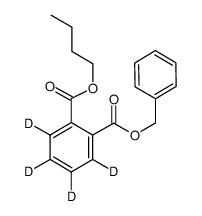93951-88-3
| Name | 2-O-benzyl 1-O-butyl 3,4,5,6-tetradeuteriobenzene-1,2-dicarboxylate |
|---|---|
| Synonyms |
BBP-d4
Spatozoate-d4 Diacizer D 160-d4 Benzyl butyl phthalate-3,4,5,6-d4 Unimoll BB-d4 Santicizer 160-d4 Santicizer C 160-d4 Palatinol BB-d4 Santicizer S 106-d4 |
| Description | Benzyl butyl phthalate-d4 is the deuterium labeled Benzyl butyl phthalate[1]. Benzyl butyl phthalate, a member of phthalic acid esters (PAEs), can trigger the migration and invasion of hemangioma (HA) cells via upregulation of Zeb1. Benzyl butyl phthalate activates aryl hydrocarbon receptor (AhR) in breast cancer cells to stimulate SPHK1/S1P/S1PR3 signaling and enhances formation of metastasis-initiating breast cancer stem cells (BCSCs)[2][3][4]. |
|---|---|
| Related Catalog | |
| In Vitro | Stable heavy isotopes of hydrogen, carbon, and other elements have been incorporated into drug molecules, largely as tracers for quantitation during the drug development process. Deuteration has gained attention because of its potential to affect the pharmacokinetic and metabolic profiles of drugs[1]. |
| References |
| Density | 1.114 g/mL at 25ºC |
|---|---|
| Molecular Formula | C19H16D4O4 |
| Molecular Weight | 316.38400 |
| Flash Point | 113ºC |
| Exact Mass | 316.16100 |
| PSA | 52.60000 |
| LogP | 4.00050 |
| Storage condition | 2-8°C |
| Symbol |


GHS08, GHS09 |
|---|---|
| Signal Word | Danger |
| Hazard Statements | H360Df-H410 |
| Precautionary Statements | P201-P273-P308 + P313-P501 |
| Hazard Codes | T: Toxic;N: Dangerous for the environment; |
| Risk Phrases | R61 |
| Safety Phrases | 53-45-60-61 |
| RIDADR | UN 3082 9/PG 3 |
